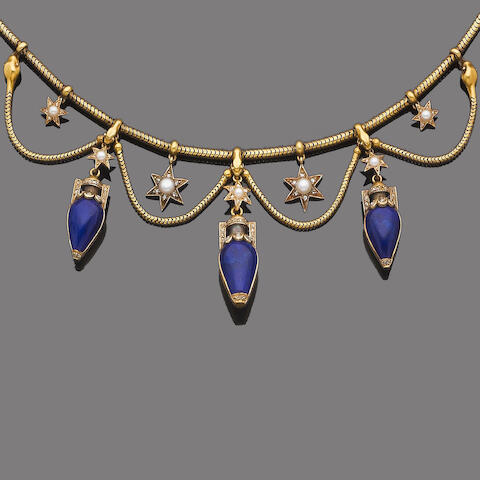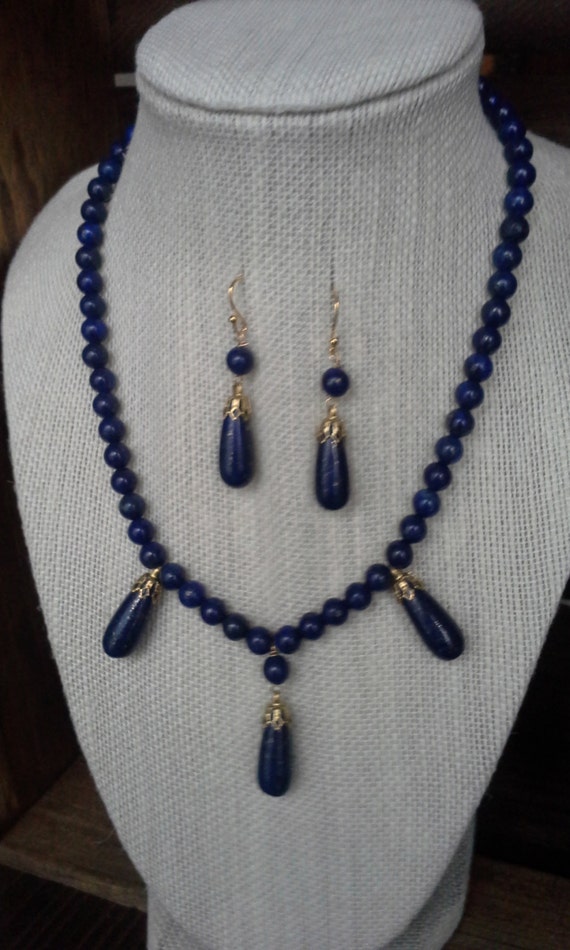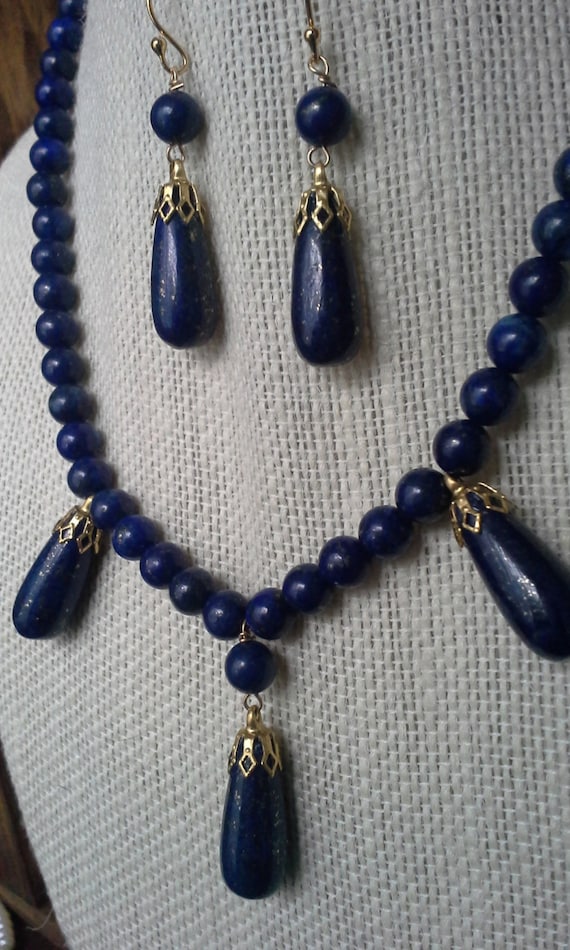History
Lapis Lazuli dates back thousands of years. It was first mined in what is today Afghanistan, then shipped around the ancient world. The earliest found examples are from 7th millenium BC. The Mesopotamians, Babylonians, and Egyptians used the stone for jewelry, decoration, and seals. It supposedly brought wisdom, warded off evil, and its blue color represented a closer connection to the star-kissed heavens. Eventually the Greeks/Romans used the stone too. It is no surprise that Lapis Lazuli found a way into the 19th century. While still very expensive, it represented the Etruscan revival that can be seen so often in jewelry of the time period.
Photographic Evidence
I am not even remotely surprised that I don't have this type of evidence available. The dark nature of lapis lazuli would be unidentifiable on camera unless it is specifically added as a notation somewhere on the photograph. Maybe one will pop up somewhere?
Textual Documentation
Here I found lapis lazuli used in many different contexts. Furniture seemed to be a popular way to set the stone, though I did discover a few references for jewelry. It seemed to be most popular at the very end of the war and beyond.Catalogues of Items for Auction by Mr. Leigh Sotheby, 1830-1860
EDITORS' BOOK TABLE,Godey's Lady's Book. April, 1848
A NEW VISITING CARD.— I shall merely inform your fair readers of a new fashion for visiting-cards that has been started amongst the select few and is hardly likely to get vulgarized. These cards consist of a square of agate, porphyry, malachite, cornelian, or lapis -lazuli , on which the name is engraved, but are only left at the house of intimate friends, and not at the porters, but in the hands of the footman of the person it is intended for.
THE TAJ MAHAL, THE NATIONAL ERA. October 11, 1855.
These were the true tombs, the monuments for display being place in the grand hall above, which is a lofty rotunda, lighted both from above and below by screens of marble, wrought in filigree. It is paved with blocks of white marble and jasper, and ornamented with a wainscoting of sculptured tablets, representing flowers. The tombs are sarcophagi of the purest marble, exquisitely inlaid with blood-stone agate, cornelian, lapis -lazuli , and other precious stones, and surrounded with an octagonal screen six feet high, in the open tracery of which lilies, irises, and other flowers, are inter-wrought with the most intricate ornamental designs
A PAIR OF AUSTRIAN STATESMAN, THE NATIONAL ERA. September 4, 1856
During this visit to Vienna, Peter tried to advance his own political objects by all the arts of flattery, and even by bribing ministers. All were not, however, accessible either to this flatteries or his bribes. The privy-councillor, Count Strattman, to whom the Czar sent a magnificent casket, in laid with lapis -lazuli and turquoises returned in unopened, with the remark? "Let the Czar give it to some other minister who has better deserved of him." Hearing which, Peter broke out into a laugh, saying, "A thorough fool, but for once an honest one!"
Art Intelligence, Frank Lelie's Weekly, May 1858
As many of the artists engaged upon the approaching The great Lablache's collection is coming to the hammer. It is one of snuffboxes. This great artist had one hobby during life. It was to surround himself with
Singular Ornament, The Weekly Vincennes Western Sun, August 1859
A brooch worn by the Countess of K— has recently been the subject of comment among the eminent company of Polish nobility who are now exiles in Paris. Encircled by twenty brilliants upon a dark blue ground of lapis lazuli , and protected by a glass in front, may be seen—what? A portrait? A lock of hair? No, neither the one nor the other; but only four bent pins wrought together in the form of a star.
MR. AND MRS. RASHER, Godey's Lady's Book, January 1861
Here's my boudoir; I told him to put that all in yellow, with blue facings and trimmings. I cautioned him about the sofa and chairs; not to get 'em too small; for you know I'm pretty solid, and I shall want to recline on 'em when I think I'm likely to be surprised by company; so he's made 'em as large as the room will allow. That painting up there by the door, with that little La Mode illustrée: journal de la famille, April 1861
Editor's Chit-Chat, Peterson's Magazine, May 1861
Gossip for the Month, Arthur's Home Magazine, 1864
La Mode illustrée: journal de la famille, February 1865
Translation:
Brooch, bracelet, earrings and necklace of lapis-lazuli.
CHITCHAT UPON NEW YORK AND PHILADELPHIA FASHIONS, Godey's Lady's Book, October, 1865
Amethysts are now cut into heads in the style of cameos, or set with figures or initials of diamonds or pearls. Egyptian shaped ear-rings of coral, malachite, and lapis -lazuli are very fashionable, so also are cameos of all kinds.
I am still interpreting my French/German sources and finding new references each time that I do! It's easy to see that lapis lazuli was known in the mid 19th century, especially in the context of furniture. Yet I do have a few references of it being used during the Civil War in terms of jewelry. Based on the other materials often mentioned alongside lapis lazuli, it was a prized stone that few people owned.
Surviving Originals
I can understand the difficulty in dating a few of these pieces. Though it is easy to see the Etruscan revival in this jewelry, with the very Roman looking settings! Most of these hail from Europe, so the fashion must have traveled to America as so many others did during the 19th century.
Conclusion
Described as rare, elegant, expensive, often set with diamonds...lapis lazuli was not an every day stone. In fact I doubt most people even came in contact with it, as it was rare here in the U.S. It was foreign, exotic! I decided to make a set, as I do like representing some of the less common stones...With that in mind, do realize that this stone was not common in the least. It wouldn't have appeared at a country dance or with a calico dress. This set would have been extremely expensive, imported all the way from England, France, or Italy. Perhaps a gift from a cousin who took the Grand Tour? Or a token from one's own experiences on the continent? I doubt it would be seen with anything other than a ball gown, a fine detail for a wealthy woman.
I like adding a bit of period accurate variety to the materials available today for reenactors. While not as common as coral or pearl, lapis lazuli would make an excellent addition for someone whose impression involves foreign travel. Or maybe a transition to a discussion about the Grand Tour? Regardless, it's a really pretty stone that I know I'll have trouble parting with!
Signing off now...Becky's getting married soon and I need to practice my wedding speech!
~Kristen

















More great research. I Love lapis lazuli so I am glad it was at least available in the mid 19th C. even if the 99% of the era probably couldn't afford it. Also, even if that gorgeous comb is not dated, it definitely fits the shape and size of combs or the 1850s-60s era.
ReplyDeleteAbsolutely Amazing Collection of Jewellery.
ReplyDeleteVisit us @ Jewelry Manufacturer in India
Lapis Lazuli, with its deep blue hue and golden flecks, is a captivating gemstone known for its use in jewelry and art since ancient times. It symbolizes wisdom, truth, and power, making it a popular choice for those seeking both beauty and meaning in their Lapis Lazuli gemstones.
ReplyDelete